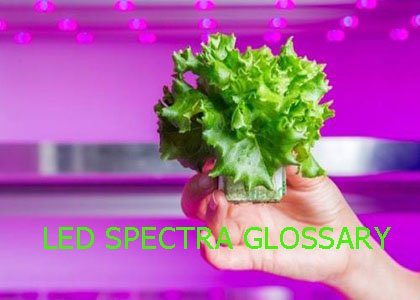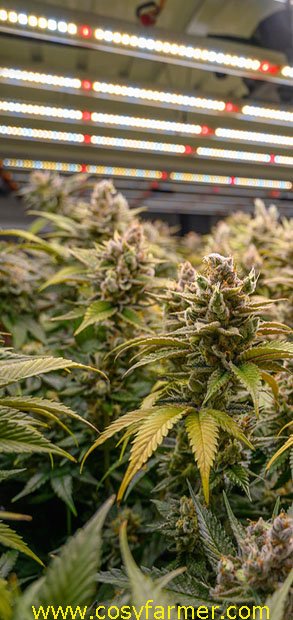
LED SPECTRA GLOSSARY
PAR
Photosynthetically
active radiation (PAR), designates the wavebands of solar radiation from 400 to
700 nanometers that photosynthetic organisms are able to use in the process of
photosynthesis. All wavelengths between 400 and 700 nm contribute to the
photosynthesis, in addition wavelengths carry information about the plant’s
surroundings.
PBAR
There is
critical information for plants beyond PAR area, in the UV range below 400 nm
and in the far- red region above 700 nm. These areas and their relative ratios
strongly affect plant growth. Hence, it is more accurate to refer to
photobiologically active radiation 280-800 nm.
R:FR(RED:FAR
RED RATIO)
The R:FR
ratio of a spectrum determines the ratio between active phytochromes (Pfr) and
inactive phytochromes (Pr). R:FR ratio is the main cue for plants about their
environment. Plants grown in shade conditions try to elongate their stem and
leaves in order to achieve a better position in the canopy (catch more light),
and produce seeds quickly (premature flowering). Sunlight has a R:FR ratio of
1.2 and light under a canopy of leaves has a R:FR ratio closer to 0.1. The
lower the R:FR ratio is, the higher is the portion of Pfr of the total
phytochromes, thus the stronger the shade avoidance response is. The R:FR
photon ratios can be calculated according to the definition by Sellaro et
al.(2010); R:FR = (650–670 nm)/(720–740 nm).
B:G(BLUE:GREEN RATIO)AND CRYEFF. ENERGY RADIATION
The B:G
ratio determines the effectiveness of the blue light responses. The B:G ratio
has also been connected to the shade avoidance response (stem and leaf
elongation). If the B:G ratio is high, plants have short internodes, stems and
leaf petioles. When increasing the green light portion of a spectrum, the blue
light responses become “lighter”; plants are not as compact and leaf
temperature increases slightly, due to partial stomatal closure. The B:G photon
ratios are calculated according to the definitions for different light colours
by Sellaro et al. 2010; B:G = (420–490 nm)/(500–570 nm). Cryptochrome activity
(CRY2, the blue-light receptor) can be calculated too, when blue light
decreases and green light increases the value is smaller.
CCT(kelvin)
CCT (Kelvin)
value is used to describe the color of a light spectrum. Generally the value is
only used to describe different colour schemes of white light, i.e. those on a
line from reddish/orange via yellow and more or less white to bluish white.
Color temperatures over 5000K are called cool colors (bluish white), while
lower color temperatures (2700–3000 K) are called warm colors (yellowish white
through red). For example, the Valoya ARCH has a CCT value of 3700, and the NS1
4800, and HPS 2100.
CRI
The color
rendering index (CRI) is a quantitative measure of the ability of a light
source to reveal the colors of various objects in comparison with an ideal or
natural light source. CRI can be used to estimate how comfortable the light it
is to human eyes, values under 50 are considered to be difficult to work under
for long time periods. CRI values for HPS are 20-40, depending on the lamp
type. CRI value for traditional red-blue LEDs is zero! CRI values for Valoya spectra
vary between 60 to 90, ensuring a comfortable working environment.
PR:PTOT
Ratio
between Pr and Ptot (photoequilibrium). Pr:Ptot ratio informs the ratio between
the mainly red light absorbing phytochromes (Pr) to all phytochromes (Ptot),
measured from a given spectrum (same as PSS value). Pfr absorbs some red light,
so in red light, there is a balance of 85% Pfr and 15% Pr. Pr absorbs very
little far-red light, so in far-red light, there is a balance of 97% Pr to 3%
Pfr.
ABSORPTION
AND ACTION SPECTRA
Absorption
spectra are measured by spectro- photometer. Action spectra are measured by
plotting a response to light as a function of a wavelength.
PHOTORECEPTORS
Plants have
the ability to sense small changes in the spectrum, intensity and direction of
light. Photoreceptors sense these light signals making it possible for the
plant to adjust its development accordingly. Three major groups of
photoreceptors have been identified: cryptochromes, phototropins and
phytochromes. In addition, UVR8 photoreceptor is involved in the perception of
UV-B radiation. Cryptochromes absorb UV-A, blue, and green wavelengths and are
involved in photomorphogenetic responses. Cryptochrome mediated responses are
for example cell elongation, stem elongation inhibition, and photoperiodic
flowering. Cryptochromes function together with red- and far-red absorbing
phytochromes.
Green light
can excite phytochromes, cryptochromes and phototropins. Green light has also
been shown to be transmitted efficiently and drive photosynthesis in deeper
layers of the leaf and enhance growth. Green light has also been shown to
reverse some blue light induced responses.
The variety
of different phytochrome responses is extensive. Phytochromes absorb red, blue,
far-red, and UV wavebands of the spectrum. Phytochromes affect stem
elongation, leaf expansion and alter plant structure in response to crowding
i.e. shade avoidance, which involves the plant perception to the changes in red
to far-red ratio. Phytochromes also contribute to flowering.
PIGMENTS AND
PHENOLICS
Chlorophylls
(a and b are found in higher plants) are greenish pigments that capture the
energy of light. Other pigments associated with the light harvesting machinery
of plants, often referred as accessory pigments (e.g. carotenoids, xanthophylls),
play an important role in photosynthesis as they increase the range of
wavelengths usable for the photosynthetic machinery.
Plants
produce a large variety of compounds classified as phenolics. They have
multiple roles, serving for example as defence against herbivores, attracting
pollinators and acting as “sunscreens”, protecting the plant cells by absorbing
shorter wavelength light (UV and blue), hence protecting the tissues from
high-light stress (photoinhibition). Some phenolic compounds affect also the
taste and flavor. Flavonoids are one of the largest group of phenolics;
anthocyanins are responsible for most of the colors observed in flowers and
fruits and together with flavones and flavonols protect cells from excessive
radiation.
photosynthesis
Photosynthesis
is about creating chemical energy (assimilates/sugars) from energy provided by
light. All wavelengths between 400 and 700 nm contribute to the photosynthesis
system, in addition wavelengths carry information that affects plant chemistry
and morphology. However, photons at longer wavelengths (far-red) do also
contribute to photosynthesis, this so called Emerson enhancement effect was
demonstrated in the 1950’s. The rate of photosynthesis is greater when both red
and far-red light are given together than the sum of the rates when given
apart. This provided evidence that there are two photochemical systems working
in tandem with a bit different wavelength optima. These are now known as
photosystem I and photosystem II. Using the current PAR limits may lead to
underestimation of photosynthetic carbon gain.
Photochemical
quantum efficiency measures the fraction of absorbed photons that engage in
photochemistry, almost all of them do. Energy efficiency then is another thing,
since only about a fourth of the energy in each photon is stored, rest is
converted to heat. Plants typically convert only 4% to 6% of the available
energy in radiation into biomass.
Treating
plant responses to elevated CO2 as an analog to increasing photosynthesis, one
can estimate what could be gained through enhanced photosynthesis through plant
breeding or genetic manipulation.
Over the
daily course, average photosynthetic enhancements under elevated CO2 are
estimated to be about 30%.
However, in
studies related to increased levels of CO2, it has been found that the 30%
enhancement in photosynthesis increases relative growth rate by only about 10%.
Increased
photosynthesis does not increase relative growth rate at the same speed since
enhanced carbohydrate availability can exceed many plants’ ability to fully
utilize it. This is due to nutrient or inherent internal growth limitations.
Further, focusing only on photosynthesis can give unreliable indications of spectrum performance as the measurements provide results over a short of a time period only, usually only lasting minutes.

